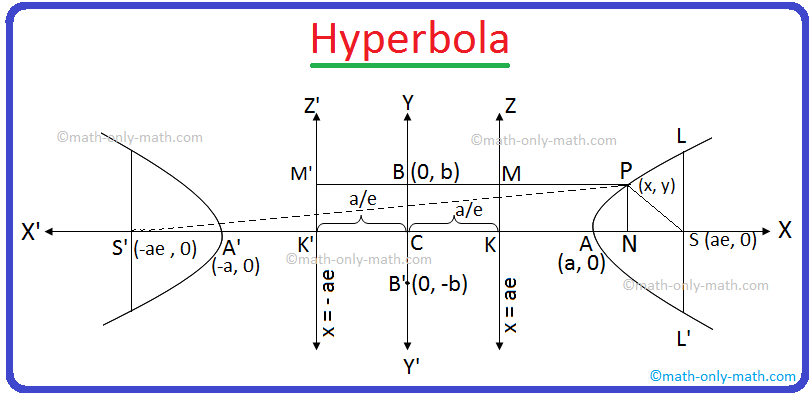Subscribe to our ▶️ YouTube channel 🔴 for the latest videos, updates, and tips.
Latus Rectum of the Hyperbola
We will discuss about the latus rectum of the hyperbola along with the examples.
Definition of the Latus Rectum of the Hyperbola:
The chord of the hyperbola through its one focus and perpendicular to the transverse axis (or parallel to the directrix) is called the latus rectum of the hyperbola.
It is a double ordinate passing through the focus. Suppose the equation of the hyperbola be \(\frac{x^{2}}{a^{2}}\) - \(\frac{y^{2}}{b^{2}}\) = 1 then, from the above figure we observe that L\(_{1}\)SL\(_{2}\) is the latus rectum and L\(_{1}\)S is called the semi-latus rectum. Again we see that M\(_{1}\)SM\(_{2}\) is also another latus rectum.
According to the diagram, the co-ordinates of the
end L\(_{1}\) of the latus
rectum L\(_{1}\)SL\(_{2}\) are (ae,
SL\(_{1}\)). As L\(_{1}\) lies on the hyperbola \(\frac{x^{2}}{a^{2}}\) - \(\frac{y^{2}}{b^{2}}\) = 1, therefore, we
get,
\(\frac{(ae)^{2}}{a^{2}}\) - \(\frac{(SL_{1})^{2}}{b^{2}}\) = 1
\(\frac{a^{2}e^{2}}{a^{2}}\) - \(\frac{(SL_{1})^{2}}{b^{2}}\) = 1
e\(^{2}\) - \(\frac{(SL_{1})^{2}}{b^{2}}\) =
1
⇒ \(\frac{(SL_{1})^{2}}{b^{2}}\) = e\(^{2}\) - 1
⇒ SL\(_{1}\)\(^{2}\) = b\(^{2}\) . \(\frac{b^{2}}{a^{2}}\), [Since, we know that, b\(^{2}\) = a\(^{2}\)(e\(^{2} - 1\))]
⇒ SL\(_{1}\)\(^{2}\) = \(\frac{b^{4}}{a^{2}}\)
Hence, SL\(_{1}\) = ± \(\frac{b^{2}}{a}\).
Therefore, the co-ordinates of the ends L\(_{1}\) and L\(_{2}\) are (ae, \(\frac{b^{2}}{a}\)) and (ae, - \(\frac{b^{2}}{a}\)) respectively and the length of latus rectum = L\(_{1}\)SL\(_{2}\) = 2 . SL\(_{1}\) = 2 . \(\frac{b^{2}}{a}\) = 2a(e\(^{2} - 1\))
Notes:
(i) The equations of the latera recta of the hyperbola \(\frac{x^{2}}{a^{2}}\) - \(\frac{y^{2}}{b^{2}}\) = 1 are x = ± ae.
(ii) A hyperbola has two latus rectum.
Solved examples to find the length of the latus rectum of a hyperbola:
Find the length of the latus rectum and equation of the latus rectum of the hyperbola x\(^{2}\) - 4y\(^{2}\) + 2x - 16y - 19 = 0.
Solution:
The given equation of the hyperbola x\(^{2}\) - 4y\(^{2}\) + 2x - 16y - 19 = 0
Now form the above equation we get,
(x\(^{2}\) + 2x + 1) - 4(y\(^{2}\) + 4y + 4) = 4
⇒ (x + 1)\(^{2}\) - 4(y + 2)\(^{2}\) = 4.
Now dividing both sides by 4
⇒ \(\frac{(x + 1)^{2}}{4}\) - (y + 2)\(^{2}\) = 1.
⇒ \(\frac{(x + 1)^{2}}{2^2} - \frac{(y + 2)^{2}}{1^{2}}\) ………………. (i)
Shifting the origin at (-1, -2) without rotating the coordinate axes and denoting the new coordinates with respect to the new axes by X and Y, we have
x = X - 1 and y = Y - 2 ………………. (ii)
Using these relations, equation (i) reduces to \(\frac{X^{2}}{2^{2}}\) - \(\frac{Y^{2}}{1^{2}}\) = 1 ………………. (iii)
This is of the form \(\frac{X^{2}}{a^{2}}\) - \(\frac{Y^{2}}{b^{2}}\) = 1, where a = 2 and b = 1.
Thus, the given equation represents a hyperbola.
Clearly, a > b. So, the given equation represents a hyperbola whose tranverse and conjugate axes are along X and Y axes respectively.
Now fine the eccentricity of the hyperbola:
We know that e = \(\sqrt{1 + \frac{b^{2}}{a^{2}}}\) = \(\sqrt{1 + \frac{1^{2}}{2^{2}}}\) = \(\sqrt{1 + \frac{1}{4}}\) = \(\frac{√5}{2}\).
Therefore, the length of the latus rectum = \(\frac{2b^{2}}{a}\) = \(\frac{2 ∙ (1)^{2}}{2}\) = \(\frac{2}{2}\) = 1.
The equations of the latus recta with respect to the new axes are X = ±ae
X = ± 2 ∙ \(\frac{√5}{2}\)
⇒ X = ± √5
Hence, the equations of the latus recta with respect to the old axes are
x = ±√5 – 1, [Putting X = ± √5 in (ii)]
i.e., x = √5 - 1 and x = -√5 – 1.
● The Hyperbola
- Definition of Hyperbola
- Standard Equation of an Hyperbola
- Vertex of the Hyperbola
- Centre of the Hyperbola
- Transverse and Conjugate Axis of the Hyperbola
- Two Foci and Two Directrices of the Hyperbola
- Latus Rectum of the Hyperbola
- Position of a Point with Respect to the Hyperbola
- Conjugate Hyperbola
- Rectangular Hyperbola
- Parametric Equation of the Hyperbola
- Hyperbola Formulae
- Problems on Hyperbola
11 and 12 Grade Math
From Latus Rectum of the Hyperbola to HOME PAGE
Didn't find what you were looking for? Or want to know more information about Math Only Math. Use this Google Search to find what you need.



New! Comments
Have your say about what you just read! Leave me a comment in the box below. Ask a Question or Answer a Question.